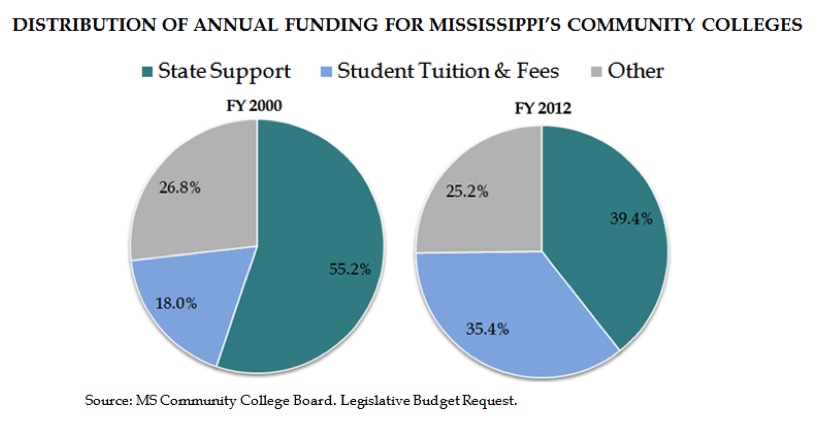COMMUNITY COLLEGE BUDGET REQUEST INCLUDES FUNDS TARGETED AT LOW-SKILLED ADULTS
September 28th, 2011
Mississippi’s community and junior colleges provide a wide variety of courses to students of all ages- academic, career tech, basic education and workforce courses. In fall 2010 and 2011, headcount enrollment in academic and career tech classes surpassed 80,000 students. Dr. Clark and the MS Community College Board requested $88.4 million more for FY2013 than the $188 million received last year. In total, the board and 15 colleges are hoping for $267.7 million from the state general fund.
Student tuition represents a substantially larger portion of revenues for the community college system than they did 12 years ago. In 2000, student tuition made up 18% of the resources coming to colleges and in FY2012 35.4% of revenues come through tuition and fees (see chart). Increases in tuition and student enrollment and limited state resources have combined to create the shift.
Over the decade, tuitions have also increased markedly for students and families. In 2000, tuition and fees came in at $1,072 per year compared to $2,117 in 2010, a considerable increase even after adjusting for inflation.
DROPOUT RECOVERY FUNDS
One of the line items in the community college budget request was for $11.5 million in ‘Dropout Recovery Funds’ for adult basic education, GED preparation courses and supports for those adults without a high school degree to return to school. In previous years, the legislature has allocated $1.5 million to the efforts and many colleges have invested in supports for adults trying to gain basic skills such as transportation vouchers or scholarships for GED testing fees. Importantly, some colleges also use funds for an additional staff member who is dedicated to helping students balance their needs outside the classroom, increasing the likelihood they will persist in classes and successfully gain a GED.
Funds dedicated to increasing the success of adults that enter basic education and GED preparation courses make good sense in a state where 388,500 adults over age 25 lack a high school degree, particularly if those investments increase the number of adults transitioning on to career tech and associate’s degree programs at the colleges. Finding additional resources to dedicate to Dropout Recovery efforts should be a priority.
Author: Sarah Welker, Policy Analyst





